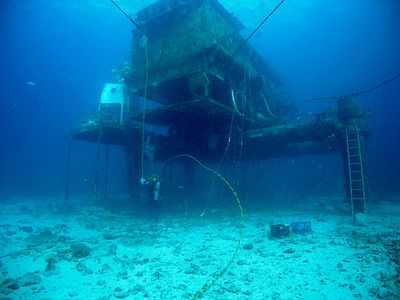Ocean engineering
Part of the Wikiversity Department of Ocean engineering and naval architecture

A NEEMO 11 crewmember works outside the undersea habitat "Aquarius".
Content summary
Herein we first explore the oceans from an oceanographic perspective, focusing on the physical characteristics and the natural processes. Further, we examine the physics of the oceans and the atmosphere, with the intent to predict the behavior of ocean systems. Finally we apply these studies to the engineering of devices within the ocean environment.
Goals
To further knowledge of the ocean as an engineering environment and to enable the practitioner to effectively design within the parameters of such.
Learning Materials
Texts
- Introduction to Oceanography; Wikibooks, the open-content textbooks collection
- Marine Hydrodynamics; Wikibooks, the open-content textbooks collection
Ocean Engineering Lessons
- Temperature
- Density
- Salinity
- Chemistry
- Periodicity
- Wave force
- Ocean currents
- Tides
- Vortices and other phenomena
- Ocean engineering design
- Models & Scaling
- Resistance
- Propulsion
- Corrosion
- Galvanic Protection
- Arctic Engineering
Assignments
Activities:
Readings:
- Physical Properties of the Oceans
- Peruse the appropriate sections of b:Introduction to Oceanography
Study guide:
- Physical Properties of the Oceans
- Wikipedia article:Temperature
- Wikipedia article:Density
- Wikipedia article:Salinity
- Wikipedia article:Chemistry
- Wikipedia article:Marine geology
- Wikipedia article:Oceanography
- Wikipedia article:Chemical oceanography
- Wikipedia article:Physical oceanography
References
Additional helpful readings include:
- Elements of Ocean Engineering; Randall, Robert E., 1997, SNAME New York
- Principles of Naval Architecture (2nd Rev.); Lewis, E.V., 1989, SNAME New York
- Water Wave Mechanics for Engineers & Scientists; R.G. Dean, 1991, World Scientific Singapore
- Descriptive Physical Oceanography; G.L. Pickard, 1990, Butterworth Heinemann Oxford
Active participants
Please sign up!! Active participants in this Learning Group
- ...
This article is issued from Wikiversity - version of the Friday, December 11, 2009. The text is available under the Creative Commons Attribution/Share Alike but additional terms may apply for the media files.